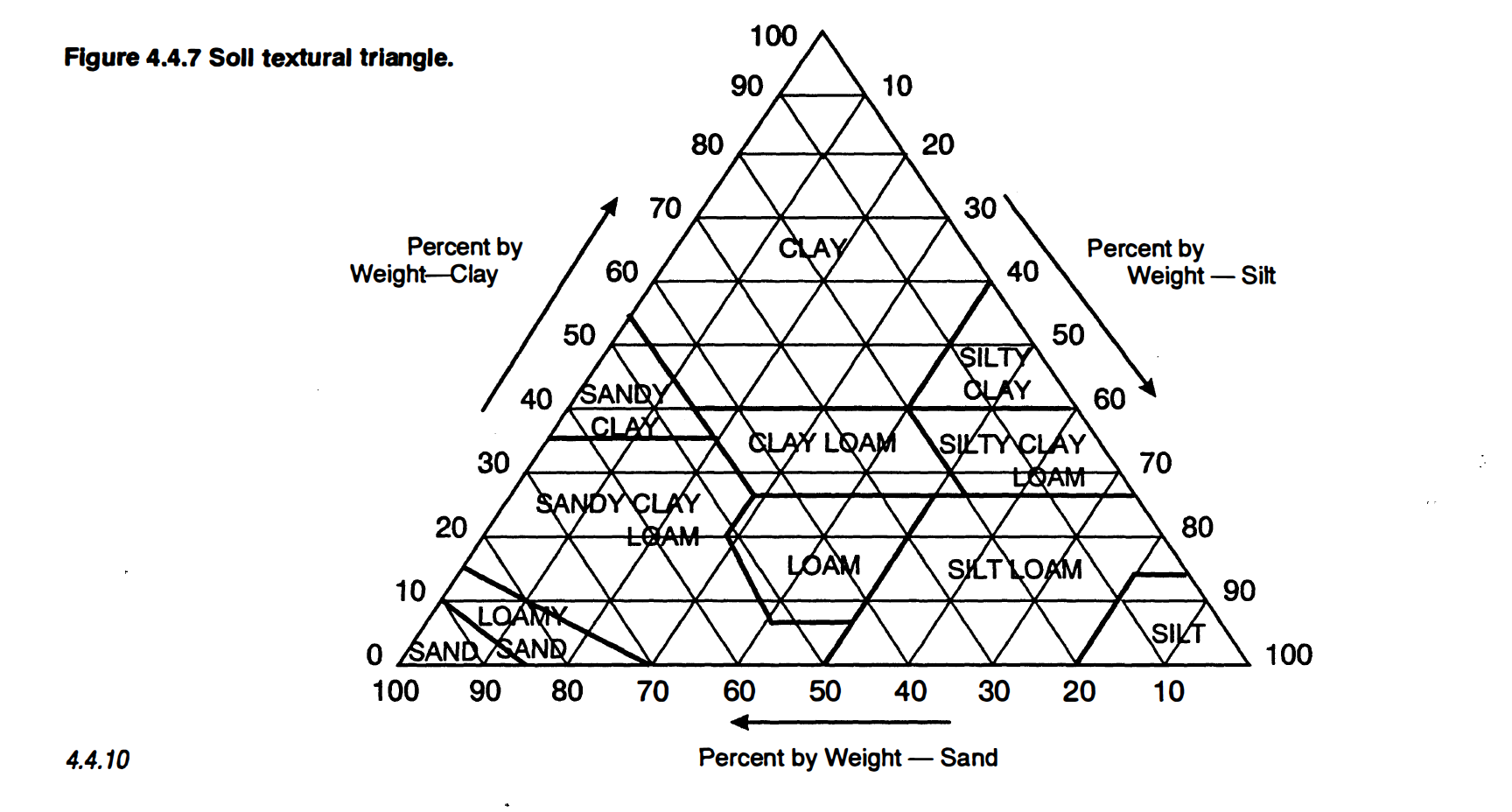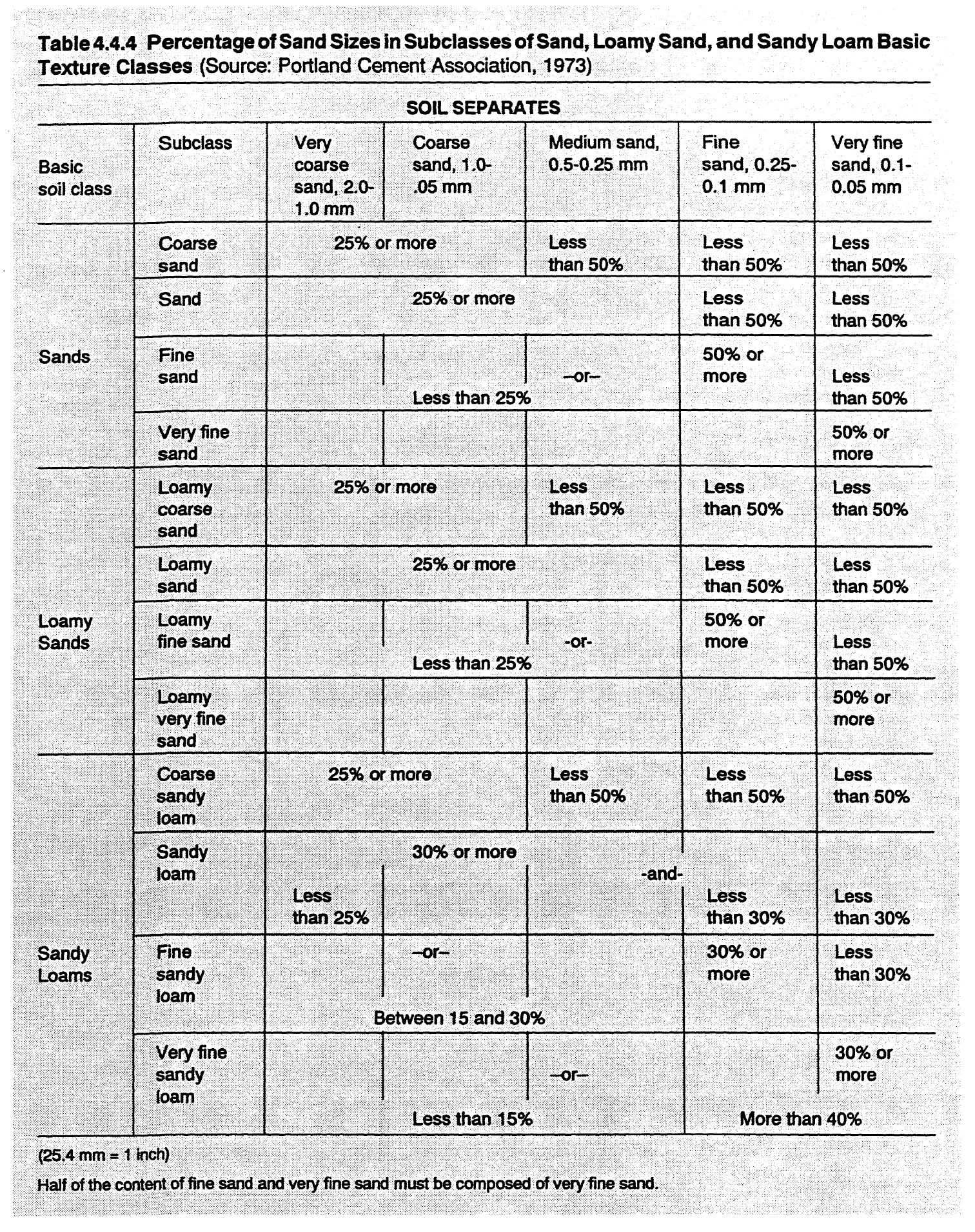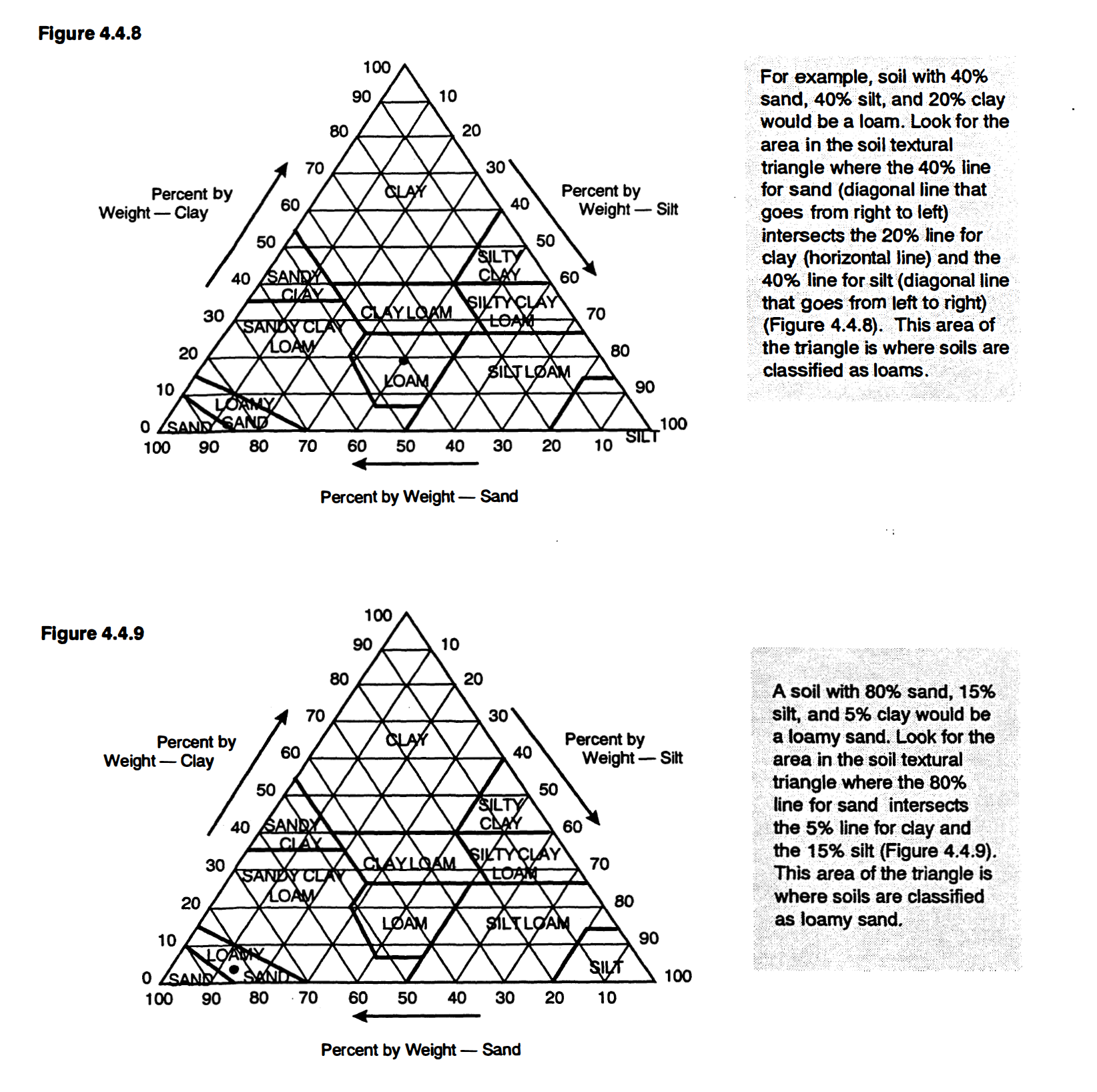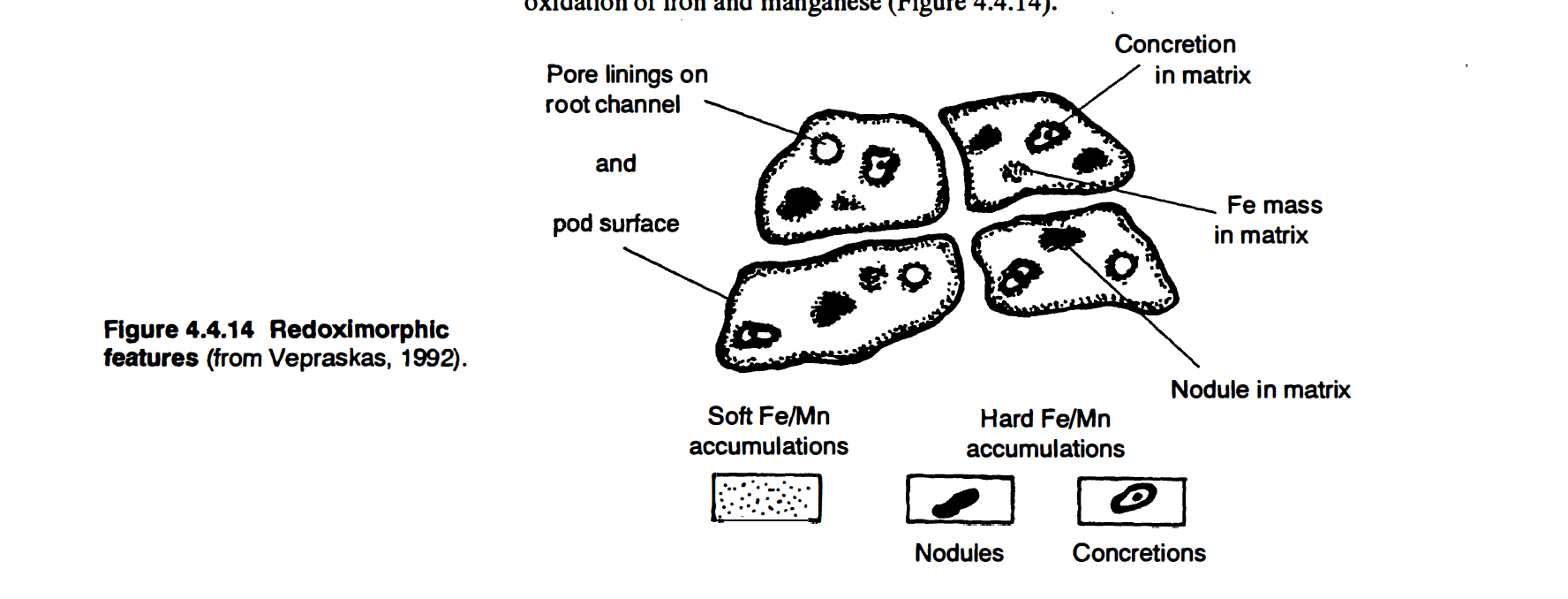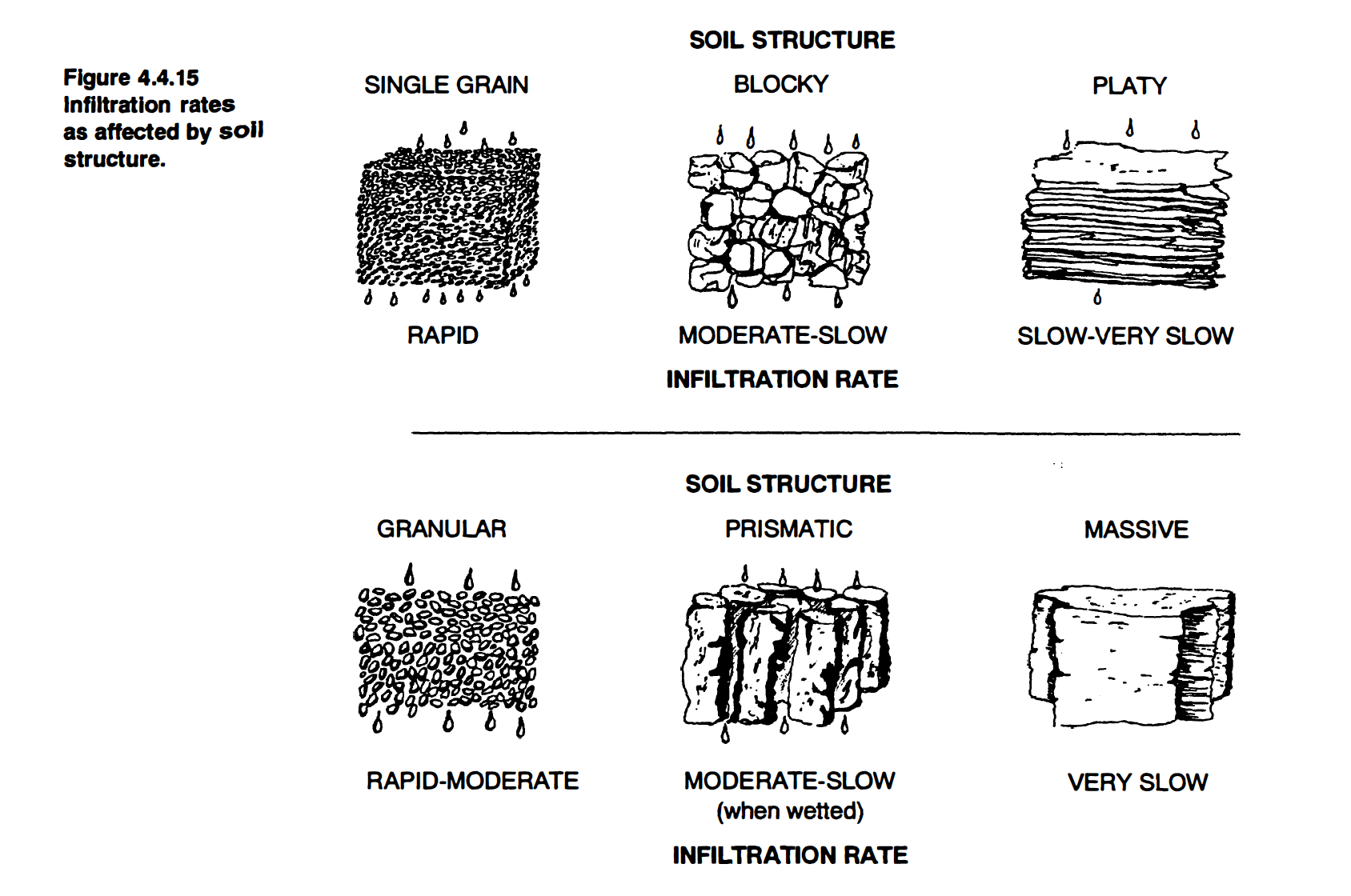There are four major morphological characteristics that are used to differentiate soil horizons. These characteristics are soil texture, soil structure, color and consistence. Information on the four major soil morphological characteristics is presented below.
Soil Texture
Soil texture refers to the solid mineral part of soils. The mineral component of the soil is separated into three sizes of inorganic particles-sand, silt, and claywhich are referred to as soil separates.
Soil particle sizes.
Each soil separate can be categorized into a particular size class. Particle size classification is based entirely on particle size and does not consider the mineralogy. The on-site sewage disposal rules of North Carolina use the U.S. Department of Agriculture (USDA) particle-size classification system. The USDA particle size classification only considers the fine-earth fraction of the inorganic particles. The maximum particle size for the fine-earth fraction is 2 millimeters. Reference 15A NCAC 18A.1935(43) (a-1)
In the USDA system, sand separates, which are the coarsest material, range in size from 2 millimeters to 0.05 millimeters diameter. Silt particles have a size range from less than 0.05 millimeters to 0.002 millimeters diameter, and is between sand and clay in size. Clay-sized particles are the smallest particles and are less than 0.002 millimeters in diameter. The relative sizes of these three particles is shown in Figure 4.4.5. See Table 4.4.3 for more details.
Diameters and Characteristics of Soil Separates
Because sands have a wide range of sizes, the particle-size class of sandytextured horizons can be further subdivided into subclasses that range from very coarse sands to very fine sands. See Table 4.4.4 for more information. It is important to realize that wastewater will flow through coarse and medium sand horizons much faster than a horizon with a fine or very fine sand texture.
Clay particles, because of their small size, have a much greater surface area for an equivalent weight compared to either silt or sand. The figure below shows the difference in surface area between a sand grain weighing 2.6 milligrams and a clay mass weighing the same (Figure 4.4.6). This increased surface area means that soils with clay have more potential sites for chemical and biological activity. Because of the increased surface area, soils with the right type and quantity of clay provide excellent sites for on-site systems ( see sections on Soil Structure and Soil Consistence).
Size comparison between one grain of sand and a mass of clay
Soil Textural Class
Most soils are a mixture of the different soil separates. The texture of the soil in each soil horizon depends on the mixture of the soil separates. Every soil can be placed into one of twelve textural classes. To find the soil textural class, the percentages of sand, silt, and clay are plotted on a textural triangle. Figure 4.4.7 shows a soil textural triangle.
Soil textural triangle.
Percentage of Sand Sizes in Subclasses of Sand, Loamy Sand, and Sandy Loam Basic Texture Classes
The idea of grouping soils into textural classes was originally developed by the USDA to assist farmers with agronomic decisions. This textural classification system has been adapted for use in siting and sizing on-site systems because texture influences the permeability of the soil, or how fast the water moves through the soil.
Below are several examples of texture determination.
Soil texture is usually determined in the field by hand testing and can be confirmed by laboratory analysis. Section 45, Soil Texture, gives more details on testing soils.
Soil voids.
In between the particles of sand, silt, and clay are spaces called voids. The voids are created because the soil particles do not fit together perfectly, leaving small, irregular spaces. Every soil has a certain percentage, normally between 35 and 50%, of its volume in voids. Soil voids are important because they determine the water and air movement possible within a soil.
Water and air flow into and out of a soil by moving through the void spaces. The ease with which water and air can flow through a soil is determined by the size of the voids, the number of voids in the soil, and how well the voids are connected to each other.
The amount, size, and connectivity of soil voids is determined, in large part, by soil texture. Therefore, soil texture becomes a critical factor determining the rate of wastewater flow through a soil horizon.
The size of the individual void spaces, in particular, has a strong influence on water movement through a soil horizon. For example, even though a clay-textured horizon will generally have more void space than a sandy-textured horizon, the movement of wastewater through a clay-textured horizon will be slower. This occurs because water can flow more quickly through the few large voids in the sand than through the many tiny voids in the clay-textured horizon. In order to account for these differences in wastewater flow, the on-site systems installed in the clay soil would require a much larger drainfield than a similar system located in a sandy soil.
Organic matter.
In addition to the soil mineral solids, soils also contain organic matter. Organic matter consists of decomposed leaves, twigs, animal droppings, air and water. Most soils have organic matter contents that range between 1 % - 5% of the total soil weight. When the majority of the solids are mineral, soils are referred to as mineral soils.
Although organic matter makes up only a small portion of the soil, it is very important in determining several soil properties.
Organic matter partially determines how much water can be held by the soil.
Organic matter increases the surface area of a soil. Increased surface area is important in the retention of some of the wastewater constituents such as viruses, phosphorus, and ammonium.
Some soils, called organic soils, are primarily composed of organic matter with only a small amount of mineral solids. Organically stained soils (soils stained by decomposing organic matter) should not be confused with organic soils. Organic soils must have more than 20% organic matter to be classified as an organic soil.
As defined but he rules, organic soils are “those organic mucks and peats consisting of more than 20% organic matter (by dry weight) and 18 inches or greater in thickness.” Reference 15A NCAC .18A .1935(21)
Organic soils are always UNSUITABLE for on-site systems because these soils do not drain properly. Treatment and disposal fields cannot function in organic soils.
Soil Color
Soil is naturally gray to white in color when it is first formed. Over time, soil develops other colors. Soil particles become coated with inorganic substances or organic matter that is translocated or moved through the soil profile. For example, organic matter, such as decaying leaves and twigs, can be translocated from the soil surface downward to the A, B, and C soil horizons by rainwater moving downward through the soil. The decaying organic matter forms a brown or black coating on the soil particles so that the soil then appears to be brown or black. A coating of iron oxide on soil particles makes a red soil.
Soil color and soil wetness.
Soil color is a very useful tool for investigations of soils for on-site wastewater disposal because color can indicate the wetness of a soil. Soils that are too wet are inappropriate for siting an on-site system. While soil color cannot directly indicate the soil's suitability, soil color does indicate much about how wet the soil is throughout the year. Because of rainfall patterns and evapotranspiration, soils in North Carolina are drier during summer and fall and wetter during winter and spring. Figure 4.4.11 demonstrates the difference in water content between seasons.
For on-site systems, two problems are associated with wet soils:
Wet soils reduce the amount of air available for bacteria to treat the wastewater.
The high water table causes the wastewater to flow directly into the ground water without sufficient treatment .
Seasonal Moisture Relations
When soils are well aerated (when air can move freely through the void spaces), there is enough oxygen to oxidize iron to its highest state (Fe•3) and the soil has a uniform bright color. This bright orange color, due to oxidized iron, is the same color that occurs when metal rusts. In this state, the soil is aerobic and soil organisms use oxygen for their metabolism.
Soils that are saturated have a different color. When a soil is saturated, water replaces the air in the void spaces, oxygen cannot move through the soil, and the soil conditions become anaerobic, or without oxygen. Many anaerobic bacteria use iron, aluminum, or sulfate as a substitute for oxygen in their metabolism. Therefore, when a soil is saturated, iron is reduced by bacteria to Fe•2 and it becomes soluble in water and can be moved or translocated out of or
Soil that always remains saturated has a gray color since the iron is gone or is in the reduced, non-color state (Fe+2). Soils that have fluctuating wetness conditions, where the soil is saturated in the winter and spring and well aerated in the summer and fall, develop a distinctive splotchy color pattern of mixed rust-orange colors and gray colors that are called soil mottling ( described in more detail on the following page). Thus, soil color becomes a good indicator of moisture status.
Munsell color system.
Soil scientists use a very specific system - the Munsell color system - to standardize soil color descriptions. In the Munsell color system, each color is broken into three components: hue, value, and chroma.through the soil.
Hue is the basic color. Hue ranges from a value of 10R, which is a red soil, to
7.5 YR or 10YR, which are brown soils, to 5Y, which is a yellow soil.
Value is the lightness or darkness of the color.
Chroma is the purity or strength of the color. Natural gray starts at O and increases to a maximum of 8.
The Munsell color book is composed of color chips with various components of hue, value, and chroma. A soil sample is compared with color chips and the appropriate color designation that matches the soil is noted and recorded.
The matrix color is the dominant soil color of the horizon. Each matrix color can have a range of value, hue, and chroma.
Two Munsell charts are displayed in Figure 4.4.12. The left color chart displays various combinations of value and chroma for a soil with a 7 .5YR hue. The right color chart shows value and chroma combinations for a soil with a lOYR hue.Value and chroma designations are added to the hue. For example, the soil in Figure 4.4.12 could be described as 7.5YR 3/2 if it has a brown matrix color and a dark gray tinge. A soil designated as lOYR 5/1 is a gray soil.
Soil Mottling.
If water cannot drain freely through the soil, then a color pattern called soil mottling usually develops. When a soil is repeatedly saturated for an extended period and drained, the iron compounds are biochemically reduced during saturation and then chemically oxidized when the soil drains. These conditions lead to a mottling pattern of bright rust- or orange-colored spots and dull graycolored spots on the background color of the soil. Soil scientists call the bright spots high chroma mottles and the dull spots low chroma mottles.
Mottles are described in terms of their abundance or number, size, and contrast compared to the background soil color. If greater than two percent of the soil contains mottles in chroma of2 or less, then the soil is generally considered wet (see Table 4.4.5). The abundance of mottles can be easily estimated using charts such as Figure 4.4.13.
Mottle Abundance, Size, and Contrast
Munsell charts.
In North Carolina, the only combination of abundance and contrast of mottles that designates a well-drained soil is few and faint. Any other combination of the mottling categories of abundance and contrast indicate potentially wet conditions.
The presence oflow-chroma colors, such as chroma 2 or lower, usually means that the soil is saturated part of the year. Often this happens when the water table rises during a wet season and saturates the soil.
The depth to low-chroma colors in a soil can help determine the depth to the seasonal wetness and the soil drainage class. This knowledge of soil wetness can be used in assessing the suitability of a soil for siting on-site systems.
As defined by the rules: “soil wetness conditions caused by a seasonal high-water table, perched water table, tidal water, seasonally saturated soils or by lateral water movement shall be determined by observation of colors of chroma 2 or less (Munsell color chart) in mottles or a solid mass.” Reference 15A NCAC .18A. 1942
Mottling abundance chart
Cautionary Note: In ascertaining soil wetness from soil color, care must be taken because in some soils, mottling can also be caused by natural variations in the parent material and notby soil wetness.
Other site characteristics can be used to indicate soil wetness. Vegetation and landscape position can both be used as an initial indicator of wet areas.
Soil Drainage Class
The SCS bas established criteria for seven soil drainage classes. The soil drainage class is a measure of bow wet the soil is during the year. Each drainage class is based on bow frequently and bow long the soil stays wet during a yearly cycle. See Table 4.4.6 for details on soil drainage classes.
Criteria for Soil Drainage Classes
Redoximorphic Features
Until 1992, soil scientists used chromas of 2 or less to signify wet soils. In 1992 the definition of a wet soil was broadened to include saturation, reduction, and morphological indicators because it was believed that color alone was not a specific enough indicator of soil wetness (Vepraskas, 1992). Under the new classification, wet soils must meet specified criteria for the following characteristics: the depth of saturation, the occurrence of reduction, and the presence of redoximorphic features. Redoximorphic features are iron nodules and mottles created by the process of reduction, translocation or movement, and finally by oxidation of iron and manganese (Figure 4.4.14).
Redoximorphic Features
Redoximorphic features could have formed in the past and may not represent current soil wetness. For this reason, all three characteristics-saturation, reduction, and redoximorphic features-must be considered.
Saturation means that a soil is periodically saturated within the first two meters. This saturation may occur in the entire two-meter layer or in a portion of that layer.
Reduction no longer refers only to the absence of oxygen but now also includes the presence of reduced iron.
Redoximorpbic features include only mottles and iron nodules formed by the reduction, translocation, and oxidation of iron and manganese due to wetness. Mottles are a broader category of features that includes redoximorphic features, carbonate accumulations, organic stains, and parent material color variation.
Redoximorphic features are not currently used to determine soil wetness in the North Carolina on-site wastewater rules.
Soil Structure
Soil structure is a measure of how the tiny particles in the soil group together, or aggregate, into units which give the soil its overall properties. Soil structure, as defined but he rules, is “ the arrangement of primary soil particles into compound particles, pets or clusters that are separated by natural planes of weakness from adjoining aggregates.” Reference 15A NCAC 18A.1935(42)
These soil aggregates, known as peds, are a mixture of all the soil components, such as sand, silt, clay, and organic matter. A per is defined in the rules as “a unit of soil structure, such as an aggregate, crumb, prism, block, or granule formed by natural processes.”
Ped dimensions range from fingernail to softball size.
Grades, sizes, and types of structure.
Soils have different grades, sizes, and types of structure. See Table 4.4.7 for more details.
The grade of a soil structure refers to the stability of the ped, a measure of how easily the ped breaks into smaller units or forms larger units. The structural grade is described when the soil is in a moist state.
The size of a soil structure refers to the size of the individual peds in a horizon. The sizes range from very fine to very coarse. Most horizons have a mixture of ped sizes; therefore, the predominant ped size in a horizon is described.
The type or form of aped (structure) refers to the shape of the ped. Parent material and organic matter can affect the shape of peds. Soils with a type of clay mineralogy, known as 1 :1 mineralogy, produce sub-angular blocky peds. Soils with 2:1 mineralogy produce angular blocky peds in the summer and massive in the winter due to drying (shrinking) and wetting (swelling) .
The effect of structure on water movement through soil.
Soil structure is an important characteristic for siting on-site systems because the structure of the soil affects the movement of water and sewage through the soil. Although the porosity is greater inside a ped, the majority of water flow is through the voids or cracks between the peds. Frequently, the only wastewater flow path in a soil that is sufficiently fast for wastewater disposal is between the peds.
Well-developed, fine peds can have an acceptable amount of wastewater flow through the voids between the peds.
The presence of peds is particularly important in clayey soils. If peds are too large in size (for example, greater than 1 inch or 2.5 cm), then wastewater will move too slowly (Figure 4.4.15).
Because soil structure affects wastewater flow, soils with certain structures, such as platy, massive, and prismatic structure, cannot be used to treat on-site waste effluent. Platy, massive, and prismatic structured soils can impede water flow, particularly in finer-textured soils.
In general, the size of the structural aggregates, or peds, increases with depth through the A and B horizons. In the C horizon the soil is massive and structureless, which means there are few or no structural aggregates. Because there are no peds present, wastewater flow through the C horizon can no longer be related to peds but is through the matrix.
Infiltration Rates
Changes in soil structure.
Soil structure is not static. Peds can be changed by natural or man-made conditions such as: wetting and drying; freezing and thawing; physical activity of roots and soil animals; influence of decaying organic matter and of slimes from microorganisms and other life forms; modifying effects of adsorbed cations, clay films, iron oxides, and aluminum oxides; and construction activities. Examples of changed soil structure are presented below.
1. Movement of wastewater through the soil can change soil structure. Sodium causes soil particles to disassociate from each other. Wastewater high in sodium (for instance, as a result of brine from a home water softener) can cause soil peds to disperse or break apart, which in tum will decrease void volume between the peds. Wastewater movement will then be restricted because the voids are much smaller.
2. Construction of on-site systems in clay soils that depend on the preservation of voids between the peds must occur during dry weather. If construction occurs during wet weather, excavation of trenches can result in clays being smeared across the face of the soil. This smearing blocks the voids between the peds and impedes the movement of wastewater. If construction does occur when the soil is wet, rake the sidewalls to remove the smeared clay.
3. Compaction, or compressing the soil, changes the amount of the total void space and the distribution of the void sizes. This reduces the space available for air and water in the soil. Soil compaction generally reduces the structural porosity, the spaces between the peds, more than the internal porosity. When structural porosity is reduced, the volume and the continuity of the larger voids that transport water are reduced (Figure 4.4.16)..
Compacted soils should be avoided for on-site systems because a compacted soil may not be able to absorb enough sewage. Soils can be compacted by heavy machinery or by frequent trips of cars, trucks, or heavy earth-moving equipment over the soil.
Soil consistence is a measure of how well the soil sticks together and how resistant peds are to being ruptured or broken.
From the North Carolina Onsite Guidance Manual



